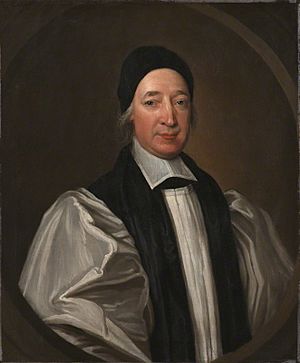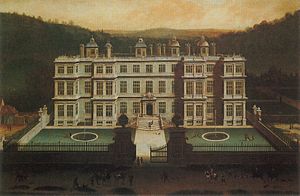Thomas Ken facts for kids
Quick facts for kids The Right ReverendThomas Ken |
|
|---|---|
 |
|
| Bishop of Bath and Wells | |
| Born | July 1637 Little Berkhampstead, Hertfordshire, England |
| Died | 19 March 1711 Longleat, Wiltshire, England |
| Venerated in | Anglican Communion |
| Major shrine | Church of St John the Baptist, Frome |
| Feast |
|
Thomas Ken (born July 1637, died March 19, 1711) was an important English church leader. He was known as one of the best "non-juring" bishops, which means he refused to swear loyalty to a new king. He also helped create many of the hymns we sing today. Hymns are religious songs or poems.
Contents
Ken's Early Life and Education
Thomas Ken was born in 1637 in Little Berkhampstead, a town in Hertfordshire, England. His father was also named Thomas Ken. His mother was the daughter of a poet named John Chalkhill. In 1646, Ken's stepsister, Anne, married Izaak Walton, who wrote a famous book called The Compleat Angler. This connection helped Ken become a kind and religious person.
In 1652, Ken started studying at Winchester College. Later, in 1656, he went to Hart Hall, Oxford University. He became a fellow at New College in 1657. He earned his first degree in 1661 and a master's degree in 1664. He also taught at his college for a while. A writer named Anthony Wood mentioned that Thomas Ken, even as a young student, would sing in musical groups at the university.
Ken became a priest in 1662. He worked in several churches, including Little Easton, Brighstone, and East Woodhay. In 1672, he left East Woodhay and went back to Winchester. By then, he was a special priest (called a prebendary) at the cathedral and a chaplain to the bishop. He was also a fellow at Winchester College.
Writing Hymns and Prayers
Ken stayed in Winchester for several years. He worked as a curate in a poorer area and wrote his Manual of Prayers for the use of the Scholars of Winchester College. This book was first published in 1674. During this time, he also wrote his famous morning, evening, and midnight hymns.
Two of his most well-known hymns are "Awake, my soul, and with the sun" and "Glory to Thee, my God, this night." The second hymn is sometimes sung as "All praise to Thee, my God, this night." Both hymns end with a short prayer called a doxology, which begins "Praise God, from whom all blessings flow." This part is still sung widely today, often to the tune called Old 100th.
In 1674, Ken traveled to Rome with his nephew, Isaac Walton. This trip helped him feel even stronger about his own church, the Anglican church.
Ken and King Charles II
In 1679, King Charles II chose Ken to be the chaplain for Princess Mary, who was married to William of Orange. While Ken was with the royal court in The Hague, he upset William. Ken insisted that a promise of marriage, made by one of the prince's relatives to an English lady, should be kept. Because of this, Ken was happy to return to England in 1680. When he arrived, he was immediately made one of the king's own chaplains.
In 1683, Ken was living in Winchester again when King Charles II visited the city with his court. The king's official mistress, Nell Gwynne, was supposed to stay at Ken's home. Ken strongly refused to let her stay there, and he successfully made her find another place. In August of that year, Ken went with Lord Dartmouth to Tangier as the chaplain for the fleet. Samuel Pepys, who was also on the trip, wrote about Ken's kind nature and his church services on board the ship.
The fleet returned in April 1684. A few months later, the position of Bishop of Bath and Wells became open. King Charles II remembered Ken's strong character in Winchester and supposedly said, "Where is the good little man that refused his lodging to poor Nell?" He decided that Ken should be the new bishop. Ken became bishop at Lambeth Palace on January 25, 1685. One of his first duties was to be with King Charles II as he was dying. Ken's wise and faithful care impressed everyone.
In this year, Ken also published his book Exposition on the Church Catechism, which is also known as The Practice of Divine Love.
Ken and King James II

In 1688, King James II reissued his Declaration of Indulgence. This declaration was meant to give more religious freedom, but many people worried it would help Roman Catholicism too much. Ken was one of the Seven Bishops who refused to publish it in their churches. He did this for two main reasons: he strongly disliked Roman Catholicism, and he felt that King James was taking away the church's spiritual freedom.
Along with the other six bishops, Ken was sent to the Tower of London on June 8, 1688. They were accused of a serious crime. Ken and the others were put on trial on June 29 and 30, and they were found not guilty.
The Non-Juring Bishops
After this trial, the Glorious Revolution quickly followed. This revolution brought new problems for Ken. He had sworn loyalty to King James, and he believed he could not break that promise by swearing loyalty to the new rulers, William and Mary. Because of this, he became one of the "non-jurors." This meant he refused to take the new oath. As he stood firm in his decision, he was replaced as bishop in August 1691 by Dr. Richard Kidder.
From this time on, Ken mostly lived a quiet life. He found a welcoming home with Lord Weymouth, a friend from his college days, at Longleat in Wiltshire. In 1703, Queen Anne asked him to become bishop again after Bishop Kidder died. However, Ken declined. He was growing weaker, and he loved the peaceful, religious life he could lead at Longleat. He did convince George Hooper to accept the position instead. Queen Anne then gave Ken a pension of £200 a year.
Ken died at Longleat on March 19, 1711. The next morning, as his friends sang "Awake, my soul, and with the sun," Bishop Ken was buried under the East Window of the Church of St. John in Frome. This church was the closest one in his old Diocese of Bath and Wells. Ken had written that he was "dying in the Holy, Catholic and Apostolic Faith professed by the whole Church... and, more particularly, in the Communion of the Church of England."
Living at Longleat Estate

When Ken lost his position as bishop in 1691 because he refused to change his oath of loyalty, his friend Lord Weymouth offered him a place to live at Longleat. Lord Weymouth also gave him £80 a year.
Ken lived on the top floor of Longleat for about twenty years. He had a strong influence on Thomas Thynne, becoming like his conscience. Thynne became known for his good deeds. While he felt these actions were his own idea, his old friends believed they were inspired by his religious friend, the Bishop.
For example, in 1707, Thynne, influenced by Ken, started a grammar school for boys in the nearby town of Warminster. It had 23 free places for local boys. This school was first called The Lord Weymouth School. In 1973, it joined with a girls' school to become Warminster School, which is still open today. Ken is remembered at Warminster School with a competitive 'house' named after him.
A part of the West Wing of Longleat was turned into a chapel for the household's daily worship. This showed the strong religious spirit that was present at Longleat during that time.
While living at Longleat, Ken wrote many of his famous hymns, including 'Awake my soul'. When he died in 1711, he left his large library of books to Lord Weymouth.
Ken's Legacy and Importance
Even though Ken wrote a lot of poetry besides his hymns, he is not considered a great poet. However, he had a special mix of spiritual understanding and poetic talent that makes him one of the best hymn-writers. He wrote "Praise God from whom all blessings flow," which is still very popular.
In his own time, Ken was a highly respected speaker in church. Even royalty would ask for seats to hear him preach. However, his sermons are not remembered today. In history, besides his three famous hymns, he is mainly remembered as a man of great honesty and strong loyalty to his beliefs. He was a "High Churchman," meaning he believed in traditional church practices.

Ken's collected poems were published in four volumes in 1721 by W. Hawkins, a relative. His other writings were published in 1838. There have been several biographies written about him, including those by John Lavicount Anderdon and Edward Hayes Plumptre.
He was buried at the Church of St John the Baptist, Frome, where his crypt can still be seen. He also has a statue in Salisbury Cathedral.
Thomas Ken is honored in the Church of England with a special day on June 8. He is also remembered in the Episcopal Church (USA) on March 21.
Ken's Writings
- A Manual of Prayer, (Winchester c. 1665) BiblioBazaar (2009) ISBN: 978-1-110-03072-9
Ken in Books
Thomas Ken appears as a character in some novels:
- In Iain Pears' An Instance of the Fingerpost (1997), Ken is shown as a young fellow at New College, Oxford. He is eager to get a church position so he can afford to marry.
- Robert Neill's historical novel Lillibullero (1975) shows Ken as a religious and kind priest. He tries, but fails, to convince King James II not to punish people harshly after the Monmouth Rebellion.

